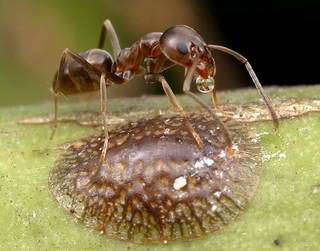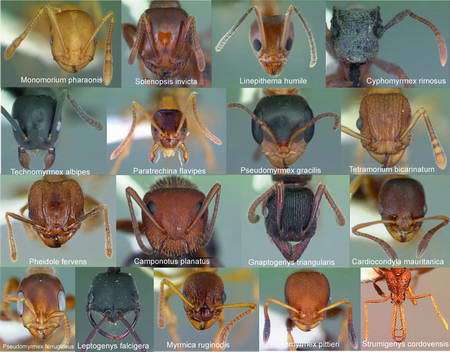Give a visiting ant a nice place to stay and it might stick around

Many insects enter the United States accidentally, as hitchhikers on various plants imported in commerce, but how many really stay?
Conventional thinking says the answer is in the numbers of both insects and times they enter, but new findings to be published in the Proceedings of the National Academy of Sciences suggest that opportunity alone is no guarantee of a successful invasion.
Image: A ground-nesting Argentine ant (Linepithema humile) feeds on the honeydew of a Brown Soft Scale (Coccus hesperidum), a pest of citrus, that is on a tangerine tree. The ant is an additional pest to citrus by spreading the scale and defending the scale from biological controls such as parasitic flies and wasps. This ant species arrived in Louisiana in 1891 and California in 1907. Photo courtesy Alex Wild (myrmecos.net)
Of 232 species of ants that entered U.S. ports uninvited from 1927 to 1985, 28 species (12 percent) now occur as established non-native species, scientists from three universities report. Their paper appears this week online in the PNAS Early Edition. An important factor in the ants’ success, they say, was nesting preferences.
“There are a huge number of species being moved around that don’t become established, so opportunity alone isn’t sufficient,” said Andrew V. Suarez, a professor in the entomology and animal biology departments at the University of Illinois at Urbana-Champaign. “This makes sense, because many of these species have specific biological characteristics that prevent them from becoming established in a new environment.”
Ants that stuck around were either ground-nesting species or arboreal species that did not depend solely on specific types of trees common to their native lands, Suarez said. “This kind of information is important, because it’s going to help us identify the characteristics that may promote the success of non-native organisms. Eventually, we can use this information to keep the new wave of invaders from becoming established.”
Suarez primarily studies Argentine ants, an aggressive species that has caused problems in Southern California since arriving in 1905 and successfully establishing large colonies that overwhelm native food webs.

Image: Species shown in the top three rows are among those identified in the USDA samples that have successfully established themselves in the United States. The five species in the bottom row were in the samples, but have not yet been successful in the U.S. Photo courtesy of Brian Fisher, California Academy of Sciencesr
His work led him to the Smithsonian Institution’s National Museum of Natural History, where he found a gold mine of untapped ant history. In numerous containers were mostly unidentified ants that the U.S. Department of Agriculture had captured at quarantine sites around the country. Each container was labeled with a port of departure and a port of entry. The ants had been collected from plants or plant material, mostly tropical in origin, before any of the ants had a chance to establish themselves.
Suarez, then a postdoctoral student, and colleague Phillip S. Ward, a professor at the University of California at Davis, spent years identifying 232 different species from 58 genera and 12 subfamilies from the 394 records stored at the museum. Suarez and Ward then teamed with David A. Holway, a professor of biology at the University of California at San Diego, to analyze their discoveries.
Of the 232 species identified, the researchers were able to determine definitive data on nest-site preferences of 156 species. Using multiple-logistic regression, the scientists tested the influence of how many times in the records particular species were imported, nesting behavior and their interaction on the success or failure of successful establishment.
Slightly more than half of 156 species they identified were tree-nesting ants, and, only 14 percent of these arboreal ants (four species) became established in the U.S., probably because they weren’t dependent on specific kinds of trees, Suarez said.
“As a group of introduced species, invasive ants are clearly important,” Holway said. “Five species of ants, for example, are included in the top 100 worst invasive organisms by the IUCN (The World Conservation Union).”
This National Science Foundation-funded study provides a rare look at data on “failed introductions for an important group of unintentionally introduced insects,” he said. “To date, few studies on introduced insects, other than those intentionally introduced for biological control, have addressed the issue of failed introductions.”
The three researchers also noted the vital role that museums play in advancing scientific inquiry, and they urged a new quarantine program to curate intercepted material.
Source: University of Illinois at Urbana-Champaign


















